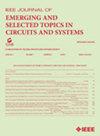BioNN:利用非线性多时间尺度混合反馈控制硬件上的生物仿真神经网络,实现神经调节爆发节奏
IF 3.7
2区 工程技术
Q2 ENGINEERING, ELECTRICAL & ELECTRONIC
IEEE Journal on Emerging and Selected Topics in Circuits and Systems
Pub Date : 2023-11-03
DOI:10.1109/JETCAS.2023.3330084
引用次数: 0
摘要
生物神经元表现出丰富而复杂的非线性动态,在硬件实现方面计算成本高、面积/功耗大。本文介绍了神经网络的数学分析和硬件实现,采用了一个非线性神经元模型,利用两个在不同时间尺度上运行的可兴奋系统。神经元由一个在多个时间尺度上运行的混合反馈系统组成,表现出与神经生理学中发现的生物物理机制相似的各种模式。单个神经元的动态来自四个电压控制电流源,具有尖峰和猝发输出模式,可使用可调参数进行控制。神经元的分叉结构被建模为一个四维动态系统,它说明了不同时间尺度的电流源在塑造神经动力学中的作用。通过研究状态空间变量和对不同参数进行分岔分析,可以全面了解系统的动态行为。该模型利用 180 纳米 CMOS 工艺在 1 毫米 x 2 毫米的原型芯片上实现。每个神经网络由 1 个孤立的测试神经元和 5 个完全连接的神经元(使用 20 个突触)组成。通过根据 I-V 特性曲线仔细选择偏置电压,神经元表现出尖峰、突发性和突发性兴奋行为。经过验证,具有抑制性或兴奋性突触的多个小规模神经网络可实现神经元猝发同相或异相的耦合节律。为了演示应用,4 个神经元网络产生的突发性波形被用来形成中央模式发生器(CPG),用于控制四足机器人 Petoi 的四条腿的运动,使机器人能够成功跳跃。本文章由计算机程序翻译,如有差异,请以英文原文为准。
BioNN: Bio-Mimetic Neural Networks on Hardware Using Nonlinear Multi-Timescale Mixed-Feedback Control for Neuromodulatory Bursting Rhythms
Biological neurons exhibit rich and complex nonlinear dynamics, which are computationally expensive and area/power hungry for hardware implementation. This paper presents a mathematical analysis and hardware realization of neural networks using a nonlinear neuron model that utilizes two excitable systems operating at different timescales. The neuron consists of a mixed-feedback system operating at multiple timescales to exhibit a variety of modalities that resemble the biophysical mechanisms found in neurophysiology. The single neuron dynamics emerge from four voltage-controlled current sources and feature spiking and bursting output modes that can be controlled using tunable parameters. The bifurcation structures of the neuron, modeled as a 4D dynamical system, illustrate the roles of sources acting on different timescales in shaping neural dynamics. A comprehensive understanding of the system’s dynamic behavior is obtained by studying the state space variables and performing bifurcation analysis on the different parameters. The model is implemented to a 1mm x 2mm prototype chip utilizing the 180nm CMOS process. Each neural network consists of 1 isolated test neuron and 5 fully connected neurons using 20 synapses. By carefully selecting bias voltages according to the I-V characterization curves, the neurons are shown to exhibit spike, burst, and burst excitable behavior. Multiple small-scale neural networks with inhibitory or excitatory synapses were verified to achieve coupled rhythms with neuron bursts in-phase or out-of-phase. To demonstrate an application, the generated burst waveforms from the 4-neuron network were used to form a Central Pattern Generator (CPG) for locomotion control of the four legs of the Petoi, a quadruped robot, enabling the bot to jump successfully.
求助全文
通过发布文献求助,成功后即可免费获取论文全文。
去求助
来源期刊

IEEE Journal on Emerging and Selected Topics in Circuits and Systems
ENGINEERING, ELECTRICAL & ELECTRONIC-
CiteScore
8.50
自引率
2.20%
发文量
86
期刊介绍:
The IEEE Journal on Emerging and Selected Topics in Circuits and Systems is published quarterly and solicits, with particular emphasis on emerging areas, special issues on topics that cover the entire scope of the IEEE Circuits and Systems (CAS) Society, namely the theory, analysis, design, tools, and implementation of circuits and systems, spanning their theoretical foundations, applications, and architectures for signal and information processing.
 求助内容:
求助内容: 应助结果提醒方式:
应助结果提醒方式:


